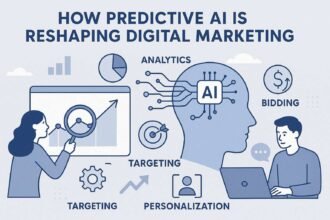Unveiling Hyper-Personalization: A Deep Dive into Tailored Marketing
Hyper-personalization refers to the use of marketing strategies and technologies to target individual consumers with specific content and offers based on their unique characteristics and behaviors. Enabled primarily by Artificial Intelligence (AI), these techniques analyze an ever-growing data set—from customer profile information to historical purchase behavior—while incorporating context such as recent consumer actions, location, and real-time weather.
The importance of personalization in marketing cannot be overstated. A study by Epsilon revealed that 80% of customers are more likely to make a purchase when brands offer personalized incentives tailored to their interests. Moreover, 90% of consumers reported greater loyalty toward brands that provide relevant offers and recommendations. Hyper-personalization goes beyond the basics of inserting a customer’s name in email greetings or sending birthday discount codes; instead, it aims to create an individualized customer journey by delivering the most relevant experiences to consumers exactly when and where they want them. Predicting what customers want, how they want it, and when they want it is the key to providing a truly meaningful customer experience.
The Importance of Personalization in Marketing
Personalization has become the cornerstone of modern marketing strategies. It dives into understanding precisely what customers want and why, analyzing their habits, demographics, purchase history, location, and other pertinent data to craft marketing messages that resonate on a personal level. Anyone who has ever shopped on Amazon or used Netflix’s movie recommendations has experienced personalization firsthand. Knowing what customers want ahead of time fulfills a fundamental human need—to feel understood—while removing the stress of decision-making. Personalization in marketing is about approaching consumers with care and creating targeted, individualized messages that cut through noise and clutter. As a result, marketers can acquire and delight more customers than ever before.
Modern consumer behavior necessitates that brands deliver all of their touchpoints exactly when and how customers want them. Customer journeys are no longer linear; consumer expectations shift between brand channels so rapidly that brands struggle to keep up. Even when messages arrive at the right time, many consumers feel as if brands and companies don’t seem to know anything about them. In fact, a study from Google revealed that nearly a third of US consumers feel that these brands are not competent enough to meet their expectations with relevant offers, content, and service. Considering that customers expect personalization to increase in the coming years and express a willingness to pay more for it, the need for personalized experiences has never been greater or more evident.
Understanding Consumer Behavior
The drive behind hyper-personalization is the demand for personalization on the part of the consumer. Understanding the motives of consumer behavior behind personalization is thus crucial in exploring and achieving the most successful personalization. Consumer behavior in this context relates to the manner in which consumers behave, respond, or react to the marketing of products and services. Examining how, why, when, and where consumers purchase goods or services reveals why some of them favor personalization.
Surveys and Feedback are among the primary sources for collecting data in hyper-personalization. They allow customers to express their interests and preferences explicitly, effectively mapping every stage of the customer journey and responding with relevant content and engagement. Behavioral Tracking requests permission to track customer’s browsing history and conducts a behavior analysis to understand what customers respond positively to. It identifies products related to customer browsing behavior and makes recommendations accordingly. Social Media Analytics monitors people’s social media activities, interests, and preferences, developing profiles that categorize users based on their behavior. Facebook Audience Insight is commonly used to observe potential customers’ behaviors on Facebook and Instagram, analyze their ad engagements, and enable relevant ad targeting. From these categories of data, marketers can create segments to target specific groups, while carefully considering data privacy and ethical standards such as GDPR and CCPA to ensure compliance and build consumer trust.
Data Collection Techniques
Surveys and Feedback are the oldest and primary methods of market research. Commercial organizations maintain a special department or contract a specialist company to conduct primary market research by collecting the views of the customers, the suppliers, the employees, the competitors, and the general public. These factors are very helpful in the marketing policies. There are many methods of conducting such surveys. A questionnaire is prepared for this purpose to collect the data. The examination may be of employees as well as customers. The employees of the organization are asked to express their opinion on the general working of the company in the onboarding phase using questionnaire method. Customers are requested to give their feedback regarding the products, the services, and the availability of the product in the delivery phase.
Behavioural Tracking involves analysing an individual’s actions across multiple digital channels including their internet activity, geolocation, app installs, online shopping, video views, search history, and more. By scraping behavioural data from different devices and site visits, companies implant tracking mechanisms in browsers through cookie technology. Using cookie data from an individual’s previous online activity, companies can personalize offerings and communications resulting in a deeply personalized customer experience. Companies gain an opportunity to be in front of the customer at the right time and in the right context.
Social Media Analytics entails analysing interactions on social media platforms such as Facebook, Instagram, Twitter, Snapchat, and LinkedIn. Customers share their interests, hobbies, likes, dislikes, and aspirations on these platforms. They share locations, product reviews, political views, and many more facets of their lives that help marketers to make these channels essential for social listening. Copyright analysis of conversations happening on these platforms helps brands make their communications relevant and highly responsive, thus hyper-personalized.
Surveys and Feedback Forms
Hyper-personalization in marketing is an individualized marketing strategy that leverages artificial intelligence and real-time data to deliver tailored products, services, or content precisely when and where an individual consumer desires them. This finely tuned approach originates from product or service customization and enhances broad segmentation or market targeting by incorporating additional data into each customer journey touchpoint. Personalization represents the most consumer-centric marketing approach possible, responding directly to individual consumers’ expressed wants, needs, likes, and dislikes. By fulfilling these expectations, personalization appeals directly to human emotions and motivations and, thereby, significantly affects consumer behavior.
Since its beginnings in the 2000s, hyper-personalized marketing has continuously gained value and relevance. The roots of consumer behavior demonstrate why this increases consumer acceptance and satisfaction. Consumer attitude, personality, and family members provide a base that motivates consumers to accept hyper-personalized marketing. Hyper-personalized creator marketing is a new technique that stimulates consumer interest in a product. Its implementation depends on collecting useful, accurate data; the results consequently depend on either privacy statements or regulations. Nevertheless, primary data provide direct resources for hyper-personalized marketing. Methods for obtaining primary data include , Behavioral Tracking, and Social Media Analytics. Surveys and Feedback Forms offer obvious and straightforward means of acquiring direct customer opinion and preference data.
Behavioral Tracking
Large volumes of individual-level e-commerce data can be collected, making behavioral tracking of customers’ activities one of the leading methods of data collection. Behavioral tracking includes the activity of customers on online stores, as well as the action of customers during their customer journey. The customer activity on the website can be measured by events such as searches made, clicks, views, shares, and shopping cart additions. On the other hand, a customer journey is a two-dimensional funnel with an active approach for the cognitively active customers working with a specific want or need and a passive approach for the customer that is involved in the brand but does not behave in an active fashion or does not have a specific want or need that he or she is trying to satisfy with the product or service.
In-house data can be enriched with external data from social media analytics providing a better udderstanding of core buyers and their habits. Social media data from sources such as Facebook, Google, Twitter, and Instagram can be analyzed to detect and forecast the patterns of shoppers. In such forecasts, the mood and opinions of the shoppers related to the specific service, the product, or the retailer are taken into consideration. In addition, it is possible to identify similar patterns for a community based on social media data as well as to detect the pleasure or displeasure from the shoppers. However, this process requires the usage of new techniques and tools suitable for building predictive models for the current social media data.
Social Media Analytics
Social media platforms reveal a wealth of information about people’s motivations, interests, intents, and preferences, as they are the ideal arena where individuals express themselves by articulating their thoughts and feelings regarding topics, products or brands in a natural and spontaneous way. Being able to understand this so-called unstructured data and the feelings behind it is an important task for companies wishing to explore new marketing techniques that can combine the information from the Internet of Things devices with that coming from the sources mentioned above. Hyper-personalization is considered a type of personalization that is based on the use of artificial intelligence techniques to analyze the feelings behind the opinions and motivations of individuals expressed in social media platforms, discussion forums, and review platforms.
Many tools are available for mining and analyzing the multitude of topics with their respective emotions and feelings. These open-source solutions have multiple purposes, all related to the aspect of opinion mining. They can be used for monitoring costs and trends and for detecting brand, company, and product instances in the social media. Other tools can be employed for analyzing feedback and improvement through the identification of the critical aspects of business activities, especially in the transportation and hospitality sectors.
Data Privacy and Ethical Considerations
Data privacy, a paramount concern in today’s society, centers pivotal philosophical, legal, and ethical debates in marketing. Increasingly stringent regulations necessitate responsible consumer data management, compelling marketing strategies to prioritize compliance, security, and ethical standards. By addressing these elements, organizations can effectively harness data for hyper-personalized campaigns while fostering trust that ensures ongoing consumer engagement.
In marketing, data privacy encompasses a comprehensive regulatory framework designed to safeguard consumer information. The principal goal of regulations such as the GDPR is to empower individuals to control the use of their personal data, compelling organizations to maintain transparency and protect consumer privacy. Achieving compliance and meeting consumer expectations is challenging; however, research demonstrates that investing in robust data privacy protections enhances consumer trust, which, in turn, positively influences brand reputation and purchase intentions.
Regulations and Compliance
Data Privacy and Ethical Considerations take center stage in the quest for hyper-personalized strategies. With increasing volumes of personal information flooding the market, governments of many countries have enacted legislation to regulate the use and distribution of customer data. This serves to ensure that consumer data remains safe and secure, preventing the misuse, breach, or theft of customer information. Breaches of such laws result in severe penalties and fines for the businesses involved. Regions not yet covered by specific legislation need to address the protection of consumers when businesses embark upon the use of personal data in their marketing endeavors. The importance of Personal Data Protection increases with the rising consumer awareness of risk, making it imperative for businesses to comply with relevant legislation and regulations in their specific market and region.
Adhering to these regulations extends beyond legal obligations; it is the foundation of consumer trust, which functions as a form of currency in the digital age. When brands exhibit transparency in the collection and use of customer data while respecting consumer privacy, they build a formidable base of loyal customers. Ultimately, trust strengthens consumer engagement and enhances personalization success.
Consumer Trust and Transparency
Personalization can generate a wariness and even backlash from consumers, particularly relating to sensitive data, such as information on health, finance or significant life events. When brands focus on providing a highly personalized experience, it can feel useful and relevant. Yet when companies engage in over-personalization or personalization without meaningful links to the customer journey, consumers tend to find it invasive or inappropriate. The balance between sharing personalized recommendations that shoppers want – such as items that complement recent purchases – and those that feel irrelevant or pushy is evolving and complex. Consumers are growing more sensitive, and brands need to be more thoughtful about when, why and how they collect and use data for personalization.
Now, more than ever, consumers want their personal data to be handled with respect and used to benefit their experiences with both online and offline brands. Transparency is paramount. Retailers and brands must empower each consumer to control their personal data, enabling them to receive communication and offers that align with their specific interests and preferences. The incentive for the consumer to do so is clear: a better experience and more relevant marketing messages. However, brands and retailers must first commit to delivering that experience, or they risk further eroding consumer trust.
Technologies Enabling Hyper-Personalization
Mastering hyper-personalization demands an individual approach based on customer data diversity. Gathering, analyzing, and interpreting such data spans a wide range of functions—from content creation to supply chain management—and relies on the right technologies to drive relevant, timely customer experiences. Artificial intelligence (AI) and machine learning (ML) algorithms play vital roles by transforming customer information into predictive intelligence, enabling real-time decision-making. Big data analytics scrutinizes vast datasets to reveal behavioural patterns, preferences, and customer journeys, thereby guiding the creation of tailored content for targeted audiences. Advances in AI, ML, and big data form the foundation of this process, providing the key technological capabilities that propel hyper-personalization.
Crafting a personalised customer journey begins with mapping the entire path—from first contact through consideration, transaction, support, loyalty, and advocacy—to identify all customer touchpoints. Pinpointing these intersections allows marketers to determine where customers might benefit from tailored content or messaging. The next step involves segmentation: identifying groups within the larger audience whose members share specific characteristics. Marketers employ demographic, behavioural, or psychographic criteria to partition markets strategically. Tailoring messaging and communications in this manner ensures that customers receive the right message at the right moment, guiding them smoothly along their personalized journey.
Artificial Intelligence
(AI) refers to computer systems capable of performing activities that typically require human intelligence, such as decision-making and creative processes. Machine learning, a subset of AI, focuses on enabling computers to learn from past experiences and improve over time using algorithms. Both fields have contributed significantly to recent advancements in deep learning, with their knowledge stored in vast algorithms and neural networks. These developments have greatly impacted the field of hyper-personalization.
For instance, the increased computing power has made real-time processing of internal and external data sources more feasible. Additionally, many AI technologies are now embedded in comprehensive customer interaction suites that can activate customer journey maps.
Machine Learning
(ML) uses statistical techniques to train computers to act without explicit programming. Algorithms learn from previous computations to produce reliable conclusions. The concept originated in the mid-20th century and evolved alongside the development of statistical learning theory.
ML algorithms perform specific tasks based on examples or observations. They require specialized training for each problem and extensively use probability theory, statistics, and linear algebra. Examples include:
– Supporting Vector Machines, based on game theory – Clustering, relying on information theory – Neural Networks, inspired by biological processes
Such advancements enable successful hyper-personalization strategies.
Big Data Analytics
The computing of extremely large data sets to reveal patterns and trends. Big data analytics is at the heart of modern hyper-personalized campaigns. A host of value-oriented applications lies behind the scenes at Google, Facebook, Amazon, Netflix and the like, both in identifying offers and in making sure influential content knows how to reach the right audiences.
Big data analytics can mean different things—descriptive, diagnostic, predictive, prescriptive or discovery. But relative to hyper-personalized marketing, the role is clearly the discovery of customer preferences and the prescription of better offers to match each customer journey. With big data analytics powering AI, machine learning makes it increasingly easier to implement hyper-personalization.“Marketing’s holy grail” has finally become a reality, as offers and content alike become tailored individually to the customer.
Creating Personalized Customer Journeys
Creating personalized customer journeys is an essential step when implementing hyper-personalization strategies within marketing. The customer journey encompasses every customer interaction with a business, from visiting a website for information to purchasing a product. Modern shoppers expect a hyper-personalized experience at every point of contact. Mapping the customer touchpoints and tailoring messaging throughout the entire journey serve as powerful methods not only to boost conversion rates and drive sales but also to foster brand loyalty.
Content personalization can serve multiple purposes, such as nurturing customers through the sales funnel, building connections, and incentivizing brand interaction. Content personalization is central when guiding customers through different buying process stages, achieved through tactics like branded content, webinars, and educational materials. Marketing automation tools further hyper-personalize the customer journey by executing targeted strategies based on consumers’ decisions. Special offer emails for groups at different funnel points activate engagement, while drip email campaigns can advance leads toward conversion.
Mapping Customer Touchpoints
Mapping customer touchpoints plays a pivotal role in creating personalized journeys, enabling organizations to tailor consumer communication effectively. For such mapping to be beneficial, understanding customer needs, preferences, and motivations is imperative. In the journey from awareness to purchase, customers might use several touchpoints, and each interaction represents an opportunity to make the experience more individualized and personal. The importance of hyper-personalized content lies in instead of delivering a broad-based warning—such as highlighting a winter sale to all consumers—focus shifts to reaching the exact customer interested in the winter sale at the right time.
Creating personalized content for each touchpoint allows marketers to micro-address individual customer needs and pain points. At each stage of the customer journey, content is employed to improve outcomes, corresponding with the specific challenges faced by the consumer. For example, content illustrates the value of a brand during the pre-awareness stage, addresses the brand’s differentiator at the interest stage, and does much more throughout all other phases. This content strategy helps in guiding potential customers through their journey, making the experience highly relevant and likely to convert activity into revenue.
Content Personalization Strategies
Creating tailored content requires an in-depth understanding of each customer segment as well as the development of customer touchpoints by creating personalized customer journeys. Mapping content to these customer journeys allows for the creation of content that will meet the individual needs of the customers at the different stages of the buying process. Using data such as product purchase history or article history enables the generation of personalized content.
Customer touchpoints need to be developed—typically using both paid and owned media—to realize personalization potential at scale. Google Empower Digital explains that content optimization with Google Ads can connect the experiences consumers enjoy across devices. Personalizing and optimizing ad copy helps reach a wider (and more receptive) audience, guiding Key Performance Indicators (KPIs) such as Website Traffic, Impressions, and Click-through Rate (CTR) as the campaign is created, launched, and optimized.
Segmentation and Targeting
Segmentation is a vital step in the hyper-personalization process. By categorizing the target audience into different groups, businesses can recognize consumers with similar needs, buying habits, and other characteristics. After segmentation, these groups can then be targeted with specifically designed messages. Common types of segmentation that support hyper-personalization include demographic, behavioral, and psychographic.
Demographic segmentation divides the market based on factors such as age, gender, income, and ethnicity. Behavioral segmentation focuses on the different ways consumers act in the market. Psychographic segmentation considers lifestyle and personality factors.
Demographic Segmentation
History and Wal-Mart.
Hyper-personalization is an advanced marketing technique that uses specialized data about individual customers to tailor engaging and timely messages, offers and services that speak to each consumer’s unique needs. When done well, consumers respond by buying more frequently, spending more per transaction and remaining loyal for the long term. Hyper-personalization transcends the conventional way of creating a basic profile and changing a generic communication by plugging a customer’s first name into the subject line. Instead, this approach is one-to-one, customized to the individual based on the understanding of what makes her, him or them tick and asking, “Where do they want to go?” It then guides the consumer, one step at a time, toward his or her goals.
. Demographic segmentation divides the market by specific, quantifiable characteristics such as age, gender, ethnicity, income, profession, education level, home ownership, marital status and number of children. These factors often play an important role in determining which products and services people want or need.
Behavioral Segmentation
In hyper-personalization, sorts consumers according to their classification, conversion-funnel stage, and buying behavior. The method groups customers by their shopping channels, the products they use, their buying frequency, and brand loyalty—and then further segments them on the basis of price, usage, and product sensitivity.
Starting with the classification phase, a company might segment consumers into groups such as new visitor, lead, subscriber, prospect, first-time buyer, repeat buyer, and advocate. In conversion stages, the groups evolve into lead, prospect, repeated, and loyal customers. To cover behavioral aspects like channel preferences, shoppers can be grouped into categories such as social media users, messenger users, returning customers, blog readers, and Google users.
Psychographic Segmentation
Psychographic segmentation divides a market into consumer groups according to their psychological makeup, including lifestyle, attitudes, beliefs, opinions, and values. This approach recognizes that individuals with similar demographic characteristics may exhibit different behaviors when driven by distinct psychological attributes. Analysts conducting psychographic segmentation analyze personality traits, social status, and activities, interests, or hobbies. For example, consumers considered more risk-averse may be segmented distinctly from those with a risk-taking disposition.
A profound understanding of the target audience forms the bedrock of any marketing or sales campaign. Once a firm grasps the psychographic profile of its customers, it can craft products that resonate with them, whether in their styles, designs, performance, or other attributes. The next phase in hyper-personalization utilizes this profiling in customer communication. Recognizing the traits that influence customers’ buying decisions enables pinpointing the factors that motivate them further down the sales funnel.
Case Studies of Successful Hyper-Personalization
Hyper-personalization is personal marketing tailored to the needs and behaviors of an individual consumer. It uses Artificial Intelligence (AI) and real-time data to understand exactly which products and services empathize with them and to automatically deliver personalized offers through marketing messages, emails, SMS, websites and more.
Forced by masses of existing buyer data, companies constantly look for better and more precise ways to use these data. Targeted marketing campaigns have long been the focus of any company and the main marketing strategy. The changing globalization market and competition dynamics have enabled better understanding of a single market, a targeted group or a specific buyer group. However, a much larger market has helped companies better understand their customers individually, enabling hyper-personalization to become more important and effective.
E-commerce Success Stories
A remarkable example of hyper-personalization in e-commerce is Netflix. Through data gathering and analysis, the company makes content recommendations based on user location, time of day, device type, or download history. Its categorization of Persian series and movies scoring the highest demand in each city in Iran by using artificial intelligence and machine learning techniques makes it possible to offer users personalized solutions in the content selection process and increase Netflix users’ engagement. Another case that shows the importance of personalization in user engagement is Amazon. The number of users is not the key to success of Amazon; instead, Amazon increases customer responsiveness and attracts more customers by analyzing user behavior. Also, movie or video streaming services such as Netflix, HBO Max, Apple, and Hulu use a data-driven approach to offer their customers tailor-made recommendations.
In addition, hyper-personalization also influences business-to-business relations. Too much information and communication in the digital age led B2B companies to offer tailored content to the right persons by organizing it as a response to the persona development. UNISERV German B2B personalization uses more persona-related services to improve the customer’s journey and make it more memorable. The site collects data and thus defines person groups by using AI and machine learning techniques. Machine learning uses a classification method to connect every person to a group by the number of visitors. Group membership changes based on website interaction. The different stages in the funnel of the buyer’s journey evolve, making other personas suitable for communication with customers during their visit. These personas enable the adaptation of hyper-personalized content that relates to the defined customer group.
B2B Personalization Examples
Budget insurance comparison brand Budget Shop is renowned for offering simple products and great rates. Its personalised Budget Quote emails offer a good cross-sell opportunity by helping existing Budget customers find better rates for other types of insurance.
Budget Shop collects data on policies that customers hold with the brand and uses predictive analytics to build a picture of what sort of customers are likely to buy when. When a key moment occurs—such as a customer’s new car or home purchase—a reminder email offers a personalised quote to help customers shop around for that category of insurance.
Challenges in Implementing Hyper-Personalization
One of the main challenges in implementing hyper-personalization strategies rests on the ever-growing magnitude and increasing complexity of the relevant data collected from customers. Managing and analyzing enormous volumes of data demands substantial investments in high-end software solutions and cloud infrastructure, alongside the acquisition of appropriate skills for data and resource management. This challenge has further intensified with the integration of Artificial Intelligence, which relies on vast training data sets. However, when successfully addressed, these investments yield highly rewarding returns by delivering precisely targeted and value-rich content during various stages of the customer decision journey. Well-trained AI analytics can then recognize patterns and proactively offer creative and compelling advice, turning complexity into strategic advantage.
Another critical aspect of hyper-personalization is the seamless linkage of all analytical and executional processes within the broader marketing automation framework. Business rule engines must process and interpret data-driven analytics to identify suitable contact moments and craft messages tailored to the needs, preferences, values, and interests of individual target customers. In a marketing automation or customer engagement platform, this functionality extends to triggering pertinent dialogues or executing corresponding campaigns across multiple touchpoints—including mobile, web, email, direct mail, or phone—in both inbound and outbound contexts. Achieving such sophisticated implementation necessitates either a single integrated platform or perfectly coordinated integrations of different solutions to ensure timely and accurate customer guidance.
Data Management Issues
From a technical viewpoint, the implementation of hyper-personalization can lead to significant data management challenges. It requires the collection and processing of vast amounts of data, often from multiple and diverse sources. Managing these large and continually growing volumes of data can be a complex undertaking. The data must be aggregated from numerous and varied platforms to create product, profile, segment, and customer interaction data. Moreover, the systems processing the data must be capable of handling the high demand for near real-time data processing.
Hyper-personalization demands the utilization of both historical and real-time data. Integrating these datasets can be a daunting task. Making decisions based on these analyses adds an additional layer of complexity. Often, organizations do not have a single team responsible for all aspects of data management. The profiling and segmentation processes are frequently handled by one team, while personalized customer journeys are created by another. The receipt of customer interaction data, and its routing back to both the profiling and segmentation, and personalized customer journey teams, is often managed by a third team. Ensuring that the relevant data flows appropriately among these teams requires careful coordination and collaboration.
Integration with Existing Systems
Developing a hyper-personalized system for a case company does not guarantee the system’s success. It is appropriate for a company to pursue hyper-personalization if its existing systems, business model, and new system can be seamlessly integrated with each other. Ideally, a new hyper-personalization system should be designed considering the compatibility of the existing systems of the case company. It is also ideal if the business model temporarily adapts to support the new system during the integration phase. Any discrepancies in the integration can significantly hinder the success of the hyper-personalized system.
Ensuring fruitful implementation hinges on the compatibility between the new system and these three sides. That is, the new system must be designed and implemented with a view toward existing structures, both in terms of platforms and operation. Alternatively, a new ecosystem can be organized around it, encompassing business partners, marketing media, and even transaction methods. Both routes demand strong support from top management. Without strategic alignment and backing, the value of hyper-personalization cannot be fully realized, regardless of the system’s internal development efforts.
Future Trends in Hyper-Personalization
By mastering hyper-personalization, marketers can prepare for an era when enabling technologies mature, consumer demands grow, and competitors offer increasingly refined real-time, 1-to-1 experiences. They need to stay abreast of emerging technologies and evolving consumer expectations to deliver compelling, real-time, personalized customer experiences that distinguish their brands.
The evolving landscape demands continuous tracking and benchmarking of key performance indicators (KPIs) to ensure that personalization strategies resonate with the target audiences. Best practices include testing and optimizing beyond messaging and delivery to the product experience, allowing consumers to define their preferences, and using data insights to determine whether consumers are receiving exactly what they need. Sharing such insights provides a valuable “fingertip check” on the pulse of the audience.
Emerging Technologies
Artificial Intelligence combined with Big Data Analytics has transformed marketing from automation to hyper-personalization that mirrors the sentimental thinking of human marketers. Automation is based on historical or transactional data whereas hyper-personalization digs into dynamic, real-time data to create conversations through chatbots, tailored content and monetized recommendations. Making automated experiences intelligent requires real-time behavioural and contextual data. The future of marketing is hyper-personalization, offering a highly personalized approach focused on improving customer experience.
Alexa and Siri leverage emerging technologies to transform interaction models, and retailers use these capabilities to add value to their existing products and services. Hyper-personalization in marketing is driven by Big Data, Artificial Intelligence and Machine Learning. Using historical data and behavioral analytics, marketers are able to understand each individual customer’s personality, preferences and demeanour.
Shifts in Consumer Expectations
How organisations engage their customers is changing. Gone are the days where nearly identical campaigns could be churned out to the masses. Today, customers expect advertising in all channels to immediately demonstrate relevance to their life, interests, goals and values. This paradigm is changing how organisations go to market, urging them to deeply consider: How do we double-click on our customers? How do we craft messages that resonate specifically with them? And how do we subtly inspire honesty and self-reflection in our customers to help them identify their true pain points? The answer is—hyper-personalisation.
Hyper-personalisation is an evolved form of personalisation where AI and real-time data take marketers past targeted content towards making customised experiences, recommendations and offers. Instead of crafting media targeted to a particular group, hyper-personalisation uses behavioural data and real-time triggers to identify and engage customers individually.
Measuring the Impact of Hyper-Personalization
Analyzing the effect of hyper-personalization on business outcomes can validate a company’s strategy and deliver insights that allow businesses to optimize and implement improved future hyper-personalized campaigns. Key performance indicators (KPIs) related to operational, financial, and customer success can help organizations answer specific questions about their strategies. For example, a retailer wondering if personalized product recommendations increase revenue and enhance the customer experience might track the revenue generated by featured products, the click-through rate from recommendations, and customer satisfaction scores. Highlighted benefits of hyper-personalization include higher conversion rates due to better audience targeting, increased customer loyalty, improved brand recognition, and an enhanced customer experience—each of which can be measured and monitored for impact.
Organizations can also leverage direct feedback at the brand, product, or service level to gain detailed perspectives on individual aspects of the customer experience. Incorporating such feedback into hyper-personalization strategies enables companies to listen to and learn from their customers continuously. Ecommerce companies illustrate the advantage of measuring the impact of hyper-personalization: by evaluating performances against predetermined KPIs, they can determine which recommendations correlate most highly with conversions during key sales events such as Cyber Monday and Black Friday.
Key Performance Indicators
(KPIs) measure the success of Hyper-Personalization initiatives and inform future marketing strategies. Adapted for Hyper-Personalization, Click Rates are CTRs on gated offers or CTAs, with higher click-through rates indicating greater engagement. Conversion Rates represent the percentage of users completing a desired action, such as submitting information via a gated offer. Sales Growth quantifies revenue change over time, resulting from new customers, increased customer purchases, or higher transaction sizes. Consumer Engagement captures the revenue percentage marketed for, such as click-to-purchase rates. Lastly, Client Satisfaction compiles feedback on website attributes—appearance, content, ease of navigation, and more—informing the necessary improvements in service.
Measuring performance across these five dimensions offers a comprehensive view of campaign success. Notably, effective KPIs apply beyond B2C contexts; differences across marketing activities relate more to execution and definition than strategy. Hyper-Personalization demands diligent monitoring of KPIs and analysis of client feedback to identify areas for adjustment. Recognizing shortcomings in any KPI without addressing them can result in suboptimal placement of goods and value in the market niche. Continuous testing and optimization, supported by accurate selection and measurement of KPIs, constitute essential best practices in customer-centric business approaches.
Customer Feedback and Satisfaction
Today’s savvy shopper is no doubt more user-experience and service-oriented than ever before. Indeed, customers expect the brands they choose to really understand them and deliver a natural journey based on their preferences and needs. With this customer-centric approach, relationships flourish and sales typically run on autopilot.
The success of personalization, thus, lies closely with how much brands understand their target audiences. What matters to you may not be what matters to your audience. The insights here are indeed valuable. However, the work lies in deploying the right data collection techniques that help unearth factual data about your customers. Customer Feedback and Customer Behaviors are the primary sources that elucidate the reasons behind these buying decisions and expectations.
Best Practices for Hyper-Personalization
Achieve hyper-personalization mastery by incorporating sfumato for subtle messaging nuances, delving into white-space dynamics to optimize visual hierarchy, and exploring the Google effect’s influence on memory and decision-making. Reseach the value of some forms of consumer forgetfulness in enhancing personalization strategies.
Explore the strategic advantage of customer questions, partner with the company’s innovation department for collaborative product development, and avoid directing customers to rival services in pursuit of short-term sales. Remember that rigorous testing and content optimization pave the way to long-term success.
Continuous Testing and Optimization
Mastering Hyper-Personalization clarifies the techniques of tailored marketing. It begins with the definition, evolution, and current significance of hyper-personalization, then presents the best practices summarized by the guiding principles of consumer centricity and continuous testing and optimisation.
Personalization lies at the heart of any marketing strategy because every consumer naturally seeks an individual buying experience, with products and services tailored to meet his or her own unique needs. Given this preference, it is no surprise that poisoning is also the most effective way of communicating the company’s value proposition and differentiating the offering from those of its competitors. In fact, the resultant “buying experience” can be thought of as a continuum of different offers—from the mass-produced to the individual. A growing body of research into consumer behavior helps to explain this, while an examination of the primary sources of data and relevant ethical considerations completes the picture.
Leveraging Customer Insights
The marketing discipline embraces an array of methodologies, from coupons and giveaways to conventional advertising on television, radio, and newspapers. However, the most comprehensive and transparent approach for organisations to understand customers is by conducting surveys. Direct solicited feedback from customers is invaluable. When a company establishes a direct relationship with the customer, it facilitates hyper-personalized marketing. Moreover, observing the customer in their natural environment reveals a wealth of information. No system can emulate the human brain’s capability. Human beings are intelligent because they understand themselves and behaviour principles, and can identify inconsistencies in their own behaviour. Therefore, leveraging different technologies, consumers can be observed in the act of buying—tracking and evaluating the series of steps that culminate in satisfying a want or need.
For most companies, social media is an environment in which they engage in, and is arguably the most direct feedback mechanism available. Whether verbal, written, or consumed through posts and other mediums, social media platforms provide rich contextual insights about a customer. Smartphones have made these interactions instant and ever-present. As such, social media has become a virtual_focus_group testing and reacting_touchpoint for many companies. It is an environment that has evolved and converged to engage and create meaningful dialogue with companies, brands, and services. This is a community and lifestyle. Therefore, utilising a variety of data sources for behavioural studies data collection techniques enables marketers to reveal the motivations of consumers and provide tailor-specific products that meet their wants and needs. The ultimate goal is to increment customer profitability through more efficient marketing.
Conclusion
Hyper-Personalization represents an innovative marketing technique that tailors products and services tailored to the specific requirements of each client. Such personalization methods have evolved since the beginning of the internet and will remain essential in future marketing endeavours. The desire for personalized advertising is one of the most robust consumer preferences, underscoring Hyper-Personalization as a potent marketing strategy.
Meanwhile, data protection regulations such as GDPR impose restrictions on the quantity and quality of data available for marketing activities. These directives have raised discussions regarding the practicability of Hyper-Personalization in forthcoming years. Nevertheless, the COVID-19 crisis has expedited digital transformation, altitudinizing consumer expectations towards personalized experiences and opening avenues for novel digital tools that facilitate such endeavors. Consequently, brands must navigate the challenges posed by the regulatory framework while catering to the elevated personalization demands of their clientele.












